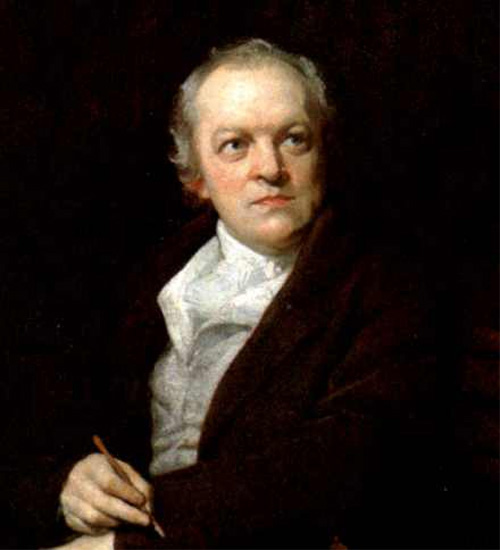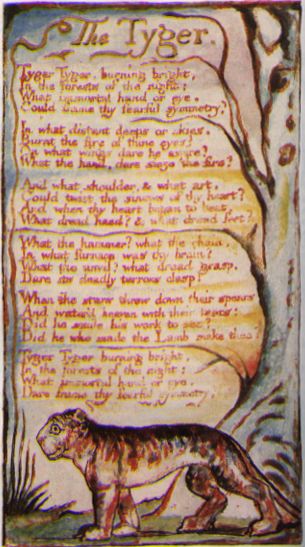WILLIAM BLAKE

THE TYGER:
Tyger! Tyger! burning bright,
In the forests of the night,
What immortal hand or eye
Could frame thy fearful symmetry?
In what distant deeps or skies
Burnt the fire of thine eyes?
On what wings dare he aspire?
What the hand dare seize the fire?
And what shoulder, and what art,
Could twist the sinews of thy heart?
And when thy heart began to beat,
What dread hand? and what dread feet?
What the hammer? what the chain?
In what furnace was thy brain?
What the anvil? what dead grasp
Dare its deadly terrors clasp?
When the stars threw down their spears,
And water'd heaven with their tears,
Did he smile his work to see?
Did he who made the Lamb make thee?
Tyger! Tyger! burning bright
In the forests of the night,
What immortal hand or eye
Dare frame thy fearful symmetry?

FROM SONGS OF EXPERIENCE
Poem page: http://www.eecs.harvard.edu/~keith/poems/tyger.html
First publication Date: 1794
The
Tyger is one of the most important poems that W. Blake wrote. I have chosen
to comment this poem because of two reasons: because this is maybe the best
known poem that Blake wrote; and be-cause the author exposes and joins many
of the romantic features and issues of the period we are stu-dying. The Tyger
was published in 1794 as one of the Songs of Experience and it is considered
the continuation and improvement of another W. Blake´s poem: “The
Lamb”.
The first impression I had when I read
this poem was very positive and also a kind of impressive, because the author,
only using direct questions, deals with two aspects: the description of the
tiger itself, or at least how the author contemplates it; and also the description
and admiration of the creator of the tiger. I was surprised of the technique
the author employed to describe both elements at the same time, and the
curious fact that he composed all the poem in a kind of questionnaire structure.
It is very clear that the title of
the poem summarizes in a very explicit way what the poem is about, at least
at the first surface impression, but of course, the poem also has a deep
meaning that must be analysed. The author writes about a tiger and more concretely
this poem is about the author´s reflection and interrogation of who-what
could make such an impressive animal that the tiger is. Indeed, almost all
the poem is written based in a very simple and direct questionnaire structure
dealing with the fact of who-what could make the tiger; it is curious to
analyse how by simple questions, the author can describe the animal, but at
the same time can describe, interrogate and reflection about how much inspiring
and imposing is the being that has created that piece of art in Nature that
the tiger is. Actually, it can be considered that the poet is more interested
in the Creator than in the tiger, and that tiger is used as a vehicle to
refer to what is really important, its creator. However, the clear addressee
of this poem (and the poet´s questions) is the tiger itself. As we
can see in the first line “Tyger! Tyger!..” :… the poet settles
an introduction, but this opening is just the medium the poet uses to explain
what he is really fascinated about and also it is a connector and conductor
to expose his Religious view. In fact, the author uses many Religious and
Classical references that I will comment in this analyse.
In terms of structure and form, the poem is divided
in six four-line stanzas. Most of the lines are seven syllables, (except
lines 4, 10, 11, 18, 20 and 24, which are eight syllable). As I have commented
before, the poem is mostly written in rhetorical questions form, and divided
also in an introduc-tion (lines 1-2), where the author settles the addressee
; a development (lines 3-19), where the poet raises his dilemma; and the conclusion
(lines 20-24), in which W. Blake gives a kind of explanation and answer of
his quandary “Did he who made the Lamb make thee?” , and also a repetition
of the first four lines, which sum up all the content of the poem and conclude
it.
There are some poetical references (most of them religious
ones) in this poem which are very interesting such as: (lines 3-4), in which
the expression “immortal hand or eye” is a classical reference to God. In
the second stanza, there are also references to “hand or eye”, (line 8) “What
the hand dare seize the fire?”, another reference to the Creator, and where
the word “fire” has several connotations (bravery, purity…). The third stanza
and fourth stanzas are also very metaphorical suggestions about the creation,
to arrive at the climax of the poem, which for me, is the most dramatic
one and which resembles more a passage of the Bible itself, than a Stanza
of the poem. Line 20: “Did he who made the Lamb make thee?” can be judged
as a question without answer (the poet does not claim if it is same creator
or not), but also evidences a parallelism between both figures: Lamb and
Tiger, and it can be supposed, that in a way, the poet thinks that the one
who has created the Lamb is the same that has created the Tiger. Indeed,
the word Lamb has here, two different meanings: one is of course a reference
to the previous W. Blake poem: “The Lamb”, and another is of course, the
one that has the word Lamb itself in a religious mean: Human being is considered
the Lamb of God, and here is where is presented one of the dilemmas that
the author has: How can it be possible that both are the same creator? I
will try to explain why the author has this dilemma later on this work.
Analysing the poem in terms of its
poetical features (metaphors, personifications, allegories…) we can observe
that this poem, despite its shortness, is very rich in these terms. Moreover,
both, the tiger, and the creator are portrayed in a very vivid and lyrical
way. For example: in the first stanza (lines 1-2) there is a metaphor and
also a personification: A tiger does not bright in the night, but it also
introduces the resemblance of the tiger with fire. Second stanza is all
a clear metaphor of the likeness that the animal has with fire. “Burnt the
fire of thine eyes?”; is an obvious symbol of the roughness of the tiger.
Stanzas three and four are powerful allegories of how fearful the tiger is
and besides, the marvel of who can have created that animal. And in fifth
stanza, my favourite one, there are several poetical symbols which are very
striking: (line 17) “When the stars threw down their spears,” and (line 18)
“And water'd heaven with their tears,” are personifications just because
stars can not cry or throw spears, but they are also an allegory of how the
tiger was created.
(Line 19), it is also a slight personification
“Did he smile his work to see?” as far as the poet assumes that the Creator
can smile. Nevertheless, the most impressive poetic resource that the author
uses is (lines 4-24) in the expression “fearful symmetry” which denotes that,
on one side the Creator is per-fect and can create perfect beings (symmetric
pieces are perfect), but all at once, presents a harmful impression with
“fearful” that presents that perfect things can also be dangerous.
Observing several elements of the poem,
we can value that the author gives some negative connotations of the figure
of the tiger and its Creator. There are various words that express an emotion
of fear, respect, admiration, horror… that the author has; such as: (line
4) “fearful symmetry”; (line 12) “dread hand/dread feet”; (line 16)
“Dare its deadly terrors clasp”; …, All this items, give the tiger as a being
a fearful and scaring representation. And here is where the dilemma of the
poet comes. From a religious point of view, the tiger symbolize all the
evil things that surround the world, and more in con-crete, from SIN, and
of course, sin is something you have to avoid and escape of its “claws” and
“jaws”. Moreover, if the Lamb (human being) is considered such a good being,
and the tiger is analysed in that negative sense… How the Creator of the
tiger and the Lamb can be the same one? or from another perspective: Is it
the same Creator? Certainly, one of the features of the romantic poetry is
the exposition of questions along the poem that usually have no reply. Taking
this into account, we can compare also the meaning of this poem with the
creation of Art, and while the tiger is the element of Inspiration in order
to make and establish the author´s quandary, it is also the Inspiration
to the creation of art. That is why I think that the title of the poem is
the most effective one, because the author does not describe the tiger, he
also uses it to initiate and summarize all his purposes and doubts.
In my opinion, this is a very complicated and
sometimes contradictory poem because it can produce several effects and opinions
in the readers. After reading this poem lots of times I still do not
know for certain if the poet fers and “hates” the tiger, or if he admires
of what the tiger entails. From my point of view, both interpretations
are possible, but if I had to choose for any of them, I will point out that
the author gives more a negative value to the tiger than a positive one. Furthermore,
I liked this poem a lot, for the reason that, it not only condenses many
Romantic ideas (Creation, Nature, Art…), but also because of its dramatic
and lyrical perspective and the elucidation that all the poem represents.
So, despite its apparent simplicity and shortness, this is a very interesting
poem that can be analysed and studied to understand Romanticism.
TO A LADY
SHE WAS A PHANTOM OF DELIGHT
VS SHE WALKS IN
BEAUTY
INDEX

